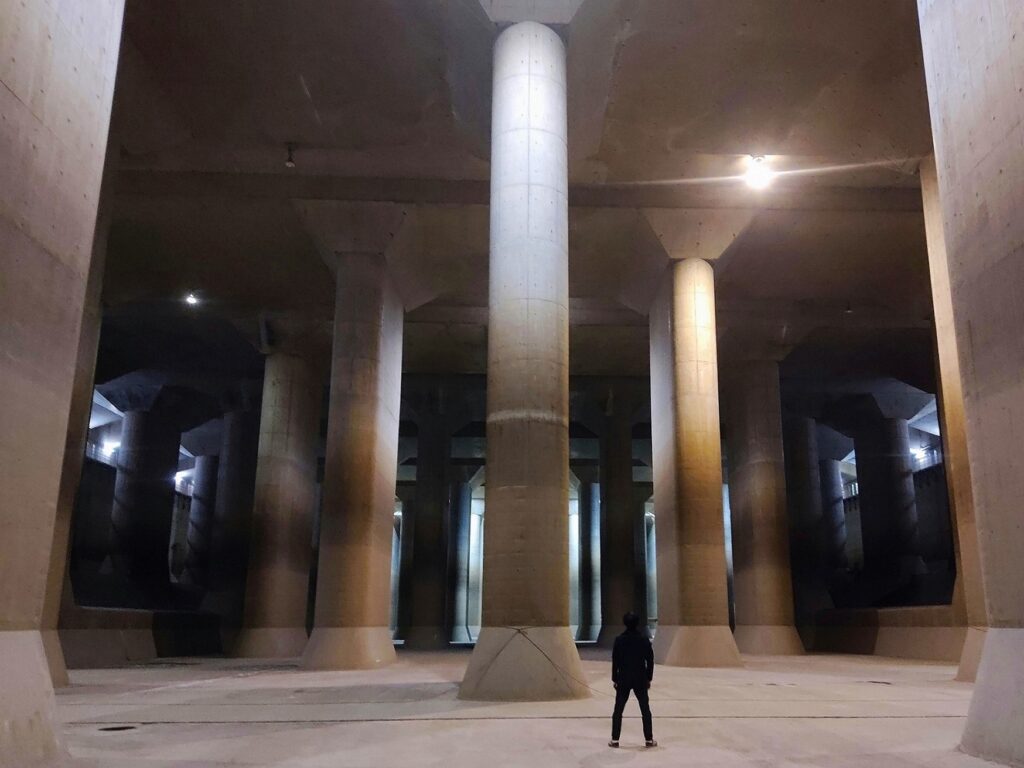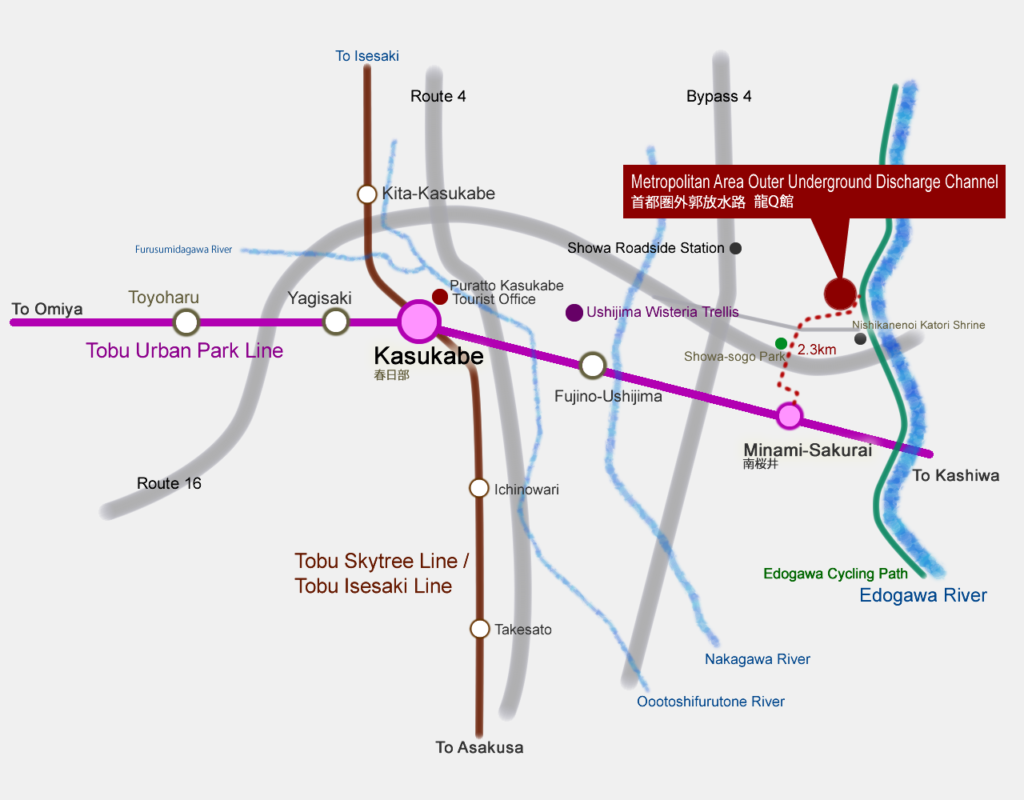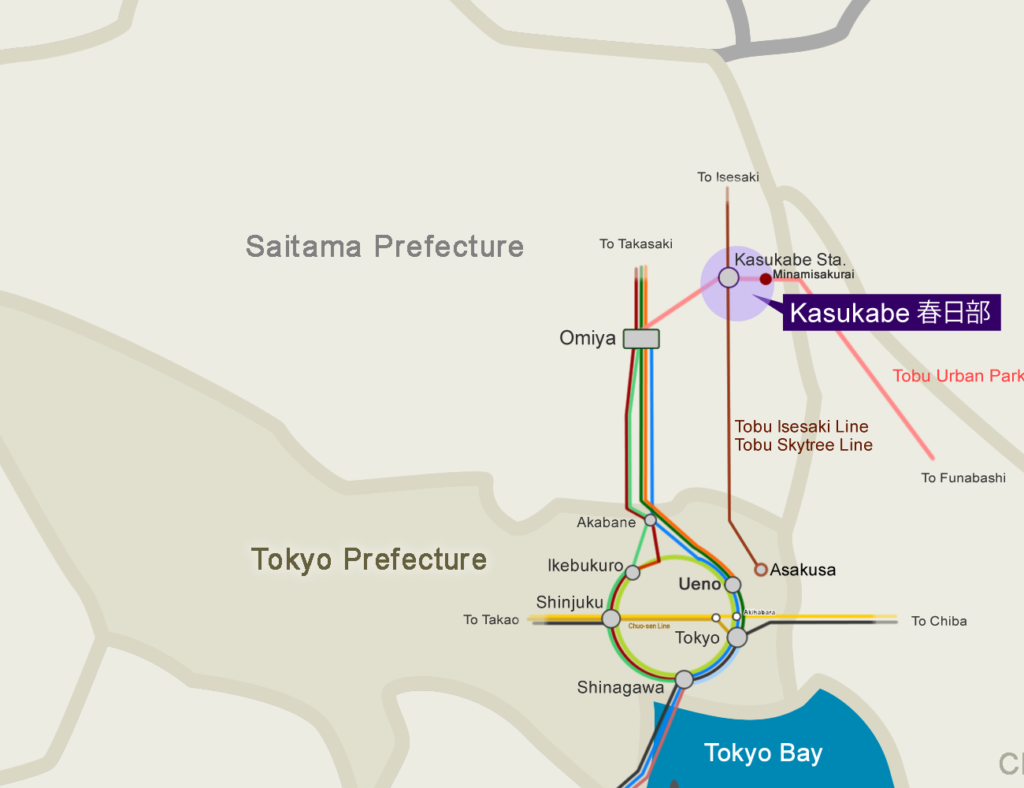Looking for a distinctive travel destination around Tokyo, giving an adventure-like experience? If so, here is one good option for you: the Metropolitan Outer Area Underground Discharge Channel. This disaster-prevention facility in Kasukabe City is a hidden tourist spot around Tokyo, resembling a colossal underground temple that beckons curious visitors. Embark on a guided tour of this extraordinary facility, granting access to areas typically off-limits to the public, allowing you to have a thrilling experience while learning about disaster controls.
What is the Metropolitan Outer Area Underground Discharge Channel?
The Metropolitan Outer Area Underground Discharge Channel (首都圏外郭放水路) is a crucial flood control infrastructure situated in Kasukabe City, Saitama Prefecture, within the greater Tokyo region. This facility reduces flood damage by diverting floodwater from small/medium-sized rivers into underground reservoirs and discharging it into a large river (Edogawa) through a spillway channel during periods of heavy rainfall.
In ancient times, the east part of Tokyo’s 23 wards and the area to the north used to be a sea, being low-lying areas today that have suffered from flooding ever since, especially those between rivers where water tends to accumulate. With the need for flood controls in the lowlands and anti-flood city development due to urbanization being essential, the construction of this large-scale facility began in 1993. The completion of a 6.3 km long facility located 50 meters underground was achieved almost 13 years later, and it is one of the world’s most extensive underground waterways.

The underground reservoir on the Metropolitan Outer Area Underground Discharge Channel
Photo provided by Saitama Prefecture Products & Tourism Association
Reproduction/Reprint prohibited
Join a tour and explore a huge facility hidden underground!
While the Metropolitan Area Outer Discharge Channel primarily operates as a restricted facility, certain sections are partially accessible to the public through guided tours. These tours offer an opportunity for visitors to gain insight into the significance of flood control measures. Despite its educational focus, the attraction of witnessing the remarkable expanse of the underground structure draws in more than 60,000 visitors annually.
The tour’s highlight is gazing over the underground reservoir between the waterway and river, known as the “Underground Temple,” with 59 columns towering in the vast tank of 177m long, 78m wide, and 18m high. The tours are available in four different courses, and in addition to touring the Underground Temple, visitors can experience the thrill of walking around a 70-meter-deep gigantic pit and peering down.
How do we apply for a tour?
There are four different tours available for individual participants and groups of 20 or more. The tour duration varies depending on the course you take, which will be 55 to 110 minutes. Detailed information on the tours and the fees is available on the official website, allowing you to select the course that best fits your interests. Advance reservations are required for all tours, and applications can be made from the official website. You can apply for a tour one month before your desired date of participation.

Be sure to know the required conditions before applying.
Remember that this is a disaster prevention facility. Participants are expected to take part in the tour with the understanding that they will be walking in a dangerous area. To participate in the tour, you must agree to conditions such as:
- The tour involves walking up and down about 100 steps on all courses. There are no elevators or escalators, so you have to walk on your own.
- The tour route includes wet, slippery, and rather dark areas. Participation in slippery shoes or heels is not allowed.
- All tours are guided verbally in Japanese. For safety, it is necessary to have someone in your group who can understand the guidance in Japanese. (an interpreter, sign language interpreter, etc.)
- An interpreter for a foreign tourist group is counted as a participant and is required to pay a tour fee.
- Reception opens 30 minutes before the tour starts. Check-in at the reception at least 10 minutes before the tour starts. If you are late, your participation will not be accepted.
- Due to inclement weather or other unforeseen circumstances, the tours may be canceled without prior notice. Tour routes may also vary for the same reasons.
Be sure to check all other conditions for participation listed on the official website. If you are unsure about participating on your own as there are many conditions, one idea is to join a tour organized by a travel agency. Some travel agencies offer package tours that combine tours of nearby attractions.
Travel tips
Getting to The Metropolitan Outer Area Underground Discharge Channel
In the case of approaching by train, take a train on the Tobu Urban Park Line (also called Tobu Noda Line) and get off at Minami-Sakurai Station(南桜井駅,) about 7 minutes from Kasukabe Station. The tour reception is at a disaster prevention museum called Ryu-Q-Kan, about 2.3 km from Minami-Sakurai Station, a 25 to 30-minute walk.
The Ryu-Q-Kan is situated in an area surrounded by farmlands near the Edogawa River, and it may be slightly challenging to find the way there. Even if it looks like a shortcut on the map, there are many narrow and easily lost paths, so it can be secure to take the relatively wide road. If you visit with a few friends, taking a taxi from Minami Sakurai Station will be convenient. For a cyclist, heading there by bike on the cycling path along the Edogawa River can be another option. Some people actually take it that way, heading up from northern Tokyo by bicycle.
 The Edogawa River Office provides information with maps in Japanese and English on their website. Location maps by Edogawa River Office https://www.ktr.mlit.go.jp/ktr_content/content/000810426.pdf
The Edogawa River Office provides information with maps in Japanese and English on their website. Location maps by Edogawa River Office https://www.ktr.mlit.go.jp/ktr_content/content/000810426.pdf
Getting around Kasukabe City
If you plan to have lunch or dinner after the tour, keep in mind that there are no restaurants near the Ryu-Q-Kan. It is advisable to go back to the area near the station to find a place to eat. The Kasukabe Station area is a hub of bistronomies for locals, featuring a variety of Izakaya bars and casual restaurants serving curry, ramen, Italian cuisine, and more. Kasukabe City is known for its setting, “Crayon Shin-chan,” a Japanese anime, and anime fans from Asian countries, such as South Korea, often visit the location. To learn more about Kusakabe City, restaurants, and attractions, visit the “Plat Kasukabe” tourist information office located near the East Exit of Kasukabe Station.
Access from Tokyo by train
Approaching from Central Tokyo (Ikebukuro, Shinjuku, Ueno) by way of Omiya Firstly, head to JR Omiya Station. For example, it is about 25 minutes from JR Ikebukuro to Omiya Station by JR Shonan-Shinjuku Line train.
From Omiya Station, change the JR line to the Tobu Line, and take the Tobu Urban Park Line to reach your station Minami-Sakurai. It is about 30 minutes between Omiya and Minami Sakurai Station.
*The ticket gates of Tobu Line and the JR Line are located at different places in the same station. Walk out of the JR’s ticket gate toward the East Exit, and you will find the Tobu Line ticket gate on the way there.
Approaching from Asakusa in Tokyo by way of Kasukabe
From Tobu Asakusa Station, take the Tobu Skytree Line bound for Kasukabe Station (about 45 min.), where you take the Tobu Urban Park Line train to reach Minami-Sakurai Station. It is about a 7-minute ride from Kasukabe to Minami-Sakurai Station.

Related Information
The Metropolitan Outer Area Underground Discharge Channel
首都圏外郭放水路
https://gaikaku.jp/
The Metropolitan Outer Area Underground Discharge Channel by Edogawa River Office
https://www.ktr.mlit.go.jp/edogawa//edogawa_index045.html
Chokotabi Saitama by Saitama Tourist Information Bureau
https://en.chocotabi-saitama.com/
Tobu Railway Co., Ltd.
https://www.tobu.co.jp/en/


